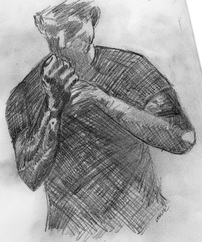Lesson 1: Weapon proximity. Our ridgehand is close to their groin so that makes it an excellent "first responder" to deal with the threat. The closer a weapon already happens to be to a target then the faster it arrives and the less likely it is to be blocked or avoided. "Good now" wins over "better later."
Lesson 2. Sometimes instead of addressing a hold directly at first, we are better off simply to cause pain. At a minimum, it will help distract their focus from applying the hold (and our counter measures to escape the hold) and it is possible that the blow will be disabling enough to where no other action is required.
Lesson 3. The left pinning check to their R. knee at the beginning of the technique is an important initial check and also helps prepare the leg for being locked later (our transfer of weight into our left pushdown block on the knee encourages the leg to lock which checks both the their leg we are contacting from striking us both with the that weight on the knee it also helps cancel out the other leg from kicking or kneeing because they would fall down if they attempted.) Often a slight adjustment back with our left foot will set the distance more naturally for our right foot to advance forward into our close kneel.
Lesson 4. The follow up after the ridgehand teaches a take down through applying a lock against their right knee. This uses the concept of opposing forces which is used wether you are locking a knee joint, an elbow, etc. We put pressure against the joint to lock it while stabilizing or counter pressing against the end of the lever that the joint is attached to. In this case, our left hand cupping behind their heel while our right forearm puts pressure right above the knee to lock it.
PLEASE NOTE: They do not fall down because we lift their foot off the mat but rather they put themselves down in an attempt to avoid the pain in their knee from the lock. The pain motivates the movement. It takes far less effort to lock a knee then to lift up somebody with one hand while kneeling on the ground! As they fall to avoid the pain, our left hand which was bracing and perhaps pulling behind their heel does lift their leg up -- exposing the groin for a stomp and just as importantly checking the leg against launching an attack as they fall.
Methods of Drill.
1. Although the left pushdown block as a check on their right knee happens immediately, new students often are slow to coordinate this action while also trying to execute the ridgehand. I highly recommend drilling the opening attack (right ridgehand to the groin) until that portion is second nature before adding the additional check. Likewise, make sure these two moves together are natural and can be applied with confidence before adding the leg locking takedown and stomp. THE INITIAL MOVEMENT IN ANY TECHNIQUE IS THE MOST CRITICAL!
2. The knee lock is an equally valid movement for stand up fighting. Drill blocking and trapping an opponent's mid level or high kick and then applying the knee lock. Work on both right and left sides.
3. Take the concept of weapon proximity and drill with your partners a variety of attacks while we sample different points of origins (starting positions) trying to pick logical stikes that allow you to hit a close target with a weapon that is conveniently available nearby.
4. Learn how to properly apply a front headlock so that your body weight is leveraging the hold and that the pressure is applied (controlled) to the wind pipe and the one side of the carotid artery. My left hand should help winch the hold in and not simply be hanging out. The better you understand the attack the better you can train to neutralize it.
5. Use a focus mitt or twin kicking target (those tear shaped bags) to train the ridgehand strike to the groin. Make sure you keep a bend in your right arm when hitting.
What's in a name? Our ridgehand (ridge meaning the backside of a sword) is used to slice our opponent's groin (testicles with a little imagination could be compared to peaches...)

 RSS Feed
RSS Feed